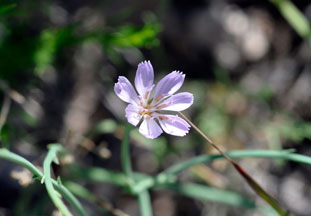RUSH SKELETONPLANT
|
 |
| File Size: 45 KB |
|
|
|
Lygodesmia juncea (Pursh ) D. Don ex Hook.
|
| Cimarron National Grassland, Morton County, Kansas |
| Perennial |
| Height: 4-28 inches |
| Family: Asteraceae - Sunflower Family |
| Flowering Period: June, July, August |
|
| Also Called: | | Rush skeletonweed. | | Stems: | | Erect, ascending, or nearly decumbent, stiff, much-branched from base, grayish green, ribbed, glabrous, waxy; sap yellowish. | | Leaves: | | Alternate, simple, few, linear, usually less than 1 1/2 inch long; upper leaves scale-like, about 1/4 inch long; margins entire; tips pointed. | | Inflorescences: | | Heads, solitary, terminal. | | Flowers: | | Bracts 5-7, linear; ray florets usually 5, pink to lavender, about 1/2 inch long; tips squared, 5-toothed; disk florets absent. | | Fruits: | | Achenes, cylindric, about 1/3 inch long, tipped with numerous hair-like bristles, enclosing small seed. | | Habitat: | | Dry, open prairies, pastures, waste areas, and roadsides, most abundant in alkaline sites. | | Distribution: | | West 2/3 of Kansas. | | Toxicity: | | Plants will accumulate nitrates. | | Forage Value: | | Rush skeletonplant is unpalatable to livestock due to bitterness. | | Uses: | | Great Plains Indians used this plant to treat diarrhea, coughs, heartburn, and kidney ailments, as well as saddle sores on their horses. After childbirth, mothers drank a tea made from the plant to enhance lactation. | | Comments: | | The stems appear leafless, which provides the common name "skeletonplant". Spherical galls often seen on the stems are caused by the gall wasp Anistrophus pisum, a parasitic insect. |
|
| Rush skeletonplant |  | | 111 KB | | Scott County, Kansas |
| | Rush skeletonplant stem galls |  | | 152 KB | | Scott County, Kansas |
| | Rush skeletonplant |  | | 63 KB | | Scott County, Kansas |
| | Rush skeleton plant habit |  | | 109 KB | | Cimarron National Grassland, Morton County, Kansas |
| | Rush skeleton plant head |  | | 54 KB | | Cimarron National Grassland, Morton County, Kansas |
| | Rush skeleton plant |  | | 63 KB | | Cimarron National Grassland, Morton County, Kansas |
| | | | |
|
|
|
|
|
|